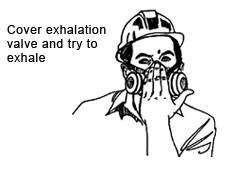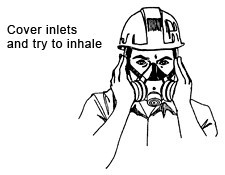2.1 Written Plan for Site or Business Group
This Respiratory Protection Program applies to all Microsoft facilities in the Puget Sound Headquarters area, excluding facilities managed by CO+I.
2.2 Training Requirements
2.2.1 Training Frequency
Respiratory Protection Program training must be provided:
Initially before workplace respirator use begins
Periodically, within 12 months of the previous training
At any time when:
Employee actions indicate that they have not retained knowledge or skills relating to safe respirator use.
Changes in the workplace or type of respirator make the previous training incomplete or obsolete.
2.2.2 Training Content
Employees training must include the following topics:
- Identification of the hazards in the workplace that make respirator use necessary. Information should include the results of the worker exposure assessment, and potential health effects and symptoms of exposure.
- Identifying and choosing the appropriate respirator and filtration cartridge, canister, or filter.
- Capabilities and limitations of respirators including the importance of seal checks prior to each use and respirator maintenance and inspection.
- How to inspect, put on (don), seal check, use, and remove (doff) the respirator, and the frequency of filter cartridge change-out.
- How to clean, disinfect, repair, and store the respirator.
- How to use the respirator effectively in emergency situations, including situations in which the respirator doesn't work properly.
- Medical signs and symptoms that may limit or prevent the effective use of respirators such as shortness of breath or dizziness.
- Microsoft’s general obligations including developing this written plan, selecting appropriate respirators, and providing medical evaluations.
2.3 General Safe Work Practices
2.3.1 Respirator Selection
A respirator will be provided to all affected employees when a risk assessment of their work activities reveals such equipment is necessary to protect their health. All respirators must be certified by the National Institute for Occupational Safety and Health (NIOSH).
The Plan Administrator will use the process outlined in Appendix A to select appropriate respirators for the work activity included in the risk assessment. The risk assessment should include an evaluation of reasonably foreseeable emergencies (such as escape, emergency, and spill response situations).
Dust masks only provide minimal protection for airborne particles only, and no protection against chemicals, gases, or vapors. Dust masks are specifically intended for use for nuisance dusts. Users requiring a higher level of protection should contact the Plan Administrator or OHS Team for determination of appropriate personal protective equipment (PPE).
2.3.2 Voluntary Use
Employees who voluntarily wear a respirator where not required will be subject to the use, storage, cleaning, maintenance, and repair sections of this program and must complete appropriate training.
Medical examinations are NOT required when employees use filtering-facepiece respirators voluntarily. Filtering-facepiece respirator is defined as a tight-fitting, half-facepiece, negative-pressure, particulate air-purifying respirator with the facepiece mainly composed of filter material. These respirators do not use cartridges or canisters and may have sealing surfaces composed of rubber, silicone or other plastic-like materials. They are sometimes referred to as "dust masks."
Medical exams are required for voluntary use of respirators with cartridges or canisters.
Respirator use is not voluntary if:
Respirator use is required
A respiratory hazard, such as exposure to a substance over the permissible exposure limit (PEL) or hazardous exposure to an airborne biological hazard, is present.
The acknowledgement form in Appendix B should be reviewed and signed by employees who voluntarily wear a respirator.
2.3.3 Medical Evaluation
Medical evaluations are required for all employees prior to the use of a respirator, at no cost to the employee. The Plan Administrator will coordinate the medical evaluations with a licensed healthcare professional (LHCP) at the Living Well Health Center (LWHC) on-campus at Building 21. Employees will complete the Employee Respirator Medical Screening Questionnaire provided by the Plan Administrator and provide it to the LHCP for review. The LHCP will determine what physical examinations an employee needs to determine if he/she is healthy enough to wear the type of respirator requested for the work activity described in the Questionnaire. The LHCP will determine if the employee is medically cleared to wear a respirator and notify the Plan Administrator.
2.3.3.1 Frequency of Medical Evaluation
The following table will determine the medical evaluation frequency:
| Type of Evaluation | When Required |
| Initial medical evaluation | Before respirators are fit tested or used in the workplace |
| Subsequent medical evaluations | Annually or earlier if the LHCP recommends.
When the Plan Administrator or employee supervisor determines that an employee needs reevaluation.
When medical signs or symptoms (such as breathing difficulties) are observed during fit-testing or reported by the employee:
When changes in worksite conditions such as physical work effort, personal protective clothing, or temperature that could substantially increase the employee's physiological stress.
When an incident investigation indicates the need for re-evaluation
|
2.3.3.2 Information Provided to the Licensed Health Care Provider (LHCP)
Based on the risk assessment, Microsoft will provide the following information to the LHCP to use in the medical clearance evaluation for employees.
Description of the respirator prescribed in the risk assessment, including the weight and type.
Description of the work activity, including:
How often the respirator will be used, for example, daily, or once a month;
How long the employee plans to wear the respirator for the work activity, for example, a minimum of one hour, or up to 12 hours;
The employee's expected physical work effort;
Types of personal protective equipment and protective clothing to be worn;
Temperature and humidity conditions expected during use.
A copy of the Microsoft Puget Sound Redmond Campus written Respiratory Protection Program and WAC 296-842. These documents are provided to the Living Well Health Center separately and kept on file there for reference.
2.3.4 Respirator Fit-Testing and Seal-Checks
Employees who wear a tight-fitting face piece respirator must pass a quantitative fit-test prior to beginning work where a respirator will be used. Fit-testing will be conducted with the employee’s assigned respirator by a qualified vendor chosen by the Plan Administrator.
The purpose of fit testing is to:
Verify that the respirator provides a good seal on the employee’s face to prevent leaks
Check for malfunctions and damage
Reinforce training and proper use of the respirator
Additionally, seal-checks must be conducted by the employee prior to each use of a respirator. This section provides the requirements for both processes.
2.3.4.1 Fit-Testing Frequency
Employees who wear tight-fitting respirators must pass a fit-test according to the following schedule:
Before employees begin performing or are assigned duties that may require the use of respirators;
Within 12 months after the previous fit-testing;
Whenever any of the following occurs:
A different type, model, or size of respirator facepiece is chosen;
A physical change occurs in an employee that could affect respirator fit. For example, facial scarring, dental changes, cosmetic surgery, or obvious weight changes;
An employee notifies Microsoft or the LHCP that the respirator fit is unacceptable. During the retest, the employee must be provided reasonable opportunity to select a different respirator facepiece (size, model, etc.).
2.3.4.2 Fit-Test Procedure Selection
An appropriate fit-testing procedure must be selected from WAC 296-842-22010 “Follow these fit-testing procedures for tight-fitting respirators”. Only quantitative fit testing is acceptable for work at Microsoft.
Quantitative fit-test procedures:
Ambient aerosol condensation nuclei counter such as the Portacount™,
Controlled negative pressure (CNP) such as the FitTester 3000™,
Generated aerosol
2.3.4.3 Respirator Seal-Check Procedures
Employees must perform a user seal check each time the respirator is put on before use. The purpose of a seal check is to make sure the respirator is properly positioned on the wearer’s face, to prevent leakage, and to detect functional problems.
User seal checks are not a substitute for fit tests.
You may use a seal check procedure recommended by the respirator manufacturer if
The manufacturer can demonstrate the procedure is based on a scientific study that demonstrates the procedure effectively identifies respirators that fit poorly when put on or adjusted.
It is approved by the Respiratory Plan Administrator.
Both the positive and negative pressure checks must be successfully completed.
2.3.4.3.1 Positive pressure check
- Remove exhalation valve cover, if removable.
- Cover the exhalation valve completely with the palm of your hand while exhaling gently to inflate the facepiece slightly.
- The respirator facepiece should remain inflated (indicating a build-up of positive pressure and no outward leakage).
If you detect no leakage, replace the exhalation valve cover (if removed), and proceed to conduct the negative pressure check
If you detect evidence of leakage, reposition the respirator (after removing and inspecting it), and try the positive pressure check again.
2.3.4.3.2 Negative pressure check
- Completely cover the inhalation opening(s) on the cartridges or canister with the palm(s) of your hands while inhaling gently to collapse the facepiece slightly.
- If you cannot use the palm(s) of your hands to effectively cover the inhalation openings on cartridges or canisters, you may use filter seal(s) (if available) or, thin rubber gloves.
- Once the facepiece is collapsed, hold your breath for 10 seconds while keeping the inhalation openings covered
- The facepiece should remain slightly collapsed (indicating negative pressure and no inward leakage).
- If you detect no evidence of leakage, the tightness of the facepiece is considered adequate, the procedure is completed, and you may now use the respirator
- If you detect leakage, reposition the respirator (after removing and inspecting it) and repeat both the positive and negative fit checks.


2.3.5 Respirator Inspection, Storage, and Cleaning
Make sure respirators are kept clean, sanitary, and in good working order.
2.3.5.1 Respirator Inspection
Inspect each respirator before each use and during cleaning. Make sure respirator inspections include the following:
The condition of the facepiece, head straps, valves, connecting tubes, and cartridge, canisters or filters
Inspect cartridges, canisters, or filters for clogged inhalation ports and ESLI color change.
Tightness of connections
Pliability and deterioration of elastomeric parts like the head strap
Do not use any respirator that is not functioning properly. Tag the respirator as “Do Not Use” and contact Microsoft OHS at Global OHS or your manager.
2.3.5.2 Respirator Storage
Respirators need to be stored flat or by hanging up in a clean, dry environment. Protect the filters by placing clean tape over the inhalation area of the filter. This will help keep unwanted contaminants and any loose particulates from inadvertently falling out.
Store respirators properly to protect them from the following:
Deformation of the facepiece or exhalation valve
Sunlight or extreme temperatures or other conditions that could shorten the useful life of the respirator
Contamination such as dust or damaging chemicals
Excessive moisture.
2.3.6 Respirator Cleaning and Disinfecting
Respirators must be cleaned and disinfected after each daily use in accordance with manufacturer’s directions with consideration for the specific work environment in which the respirator was worn. An alternate procedure for cleaning and disinfecting can be found in Appendix C.
2.3.7 Disposal of Used Canisters, Cartridges, or Filters
When canisters, cartridges, or filters become clogged, ESLI indicator changes color, or replacement is needed, place used canisters, cartridges, or filters in a sealed plastic bag and dispose of in the trash.
2.3.8 Continuous Improvement
This Respiratory Protection Program will be reviewed periodically and updated to reflect program changes. Periodic work area audits will include verification of Program elements in areas where respirators are used.

